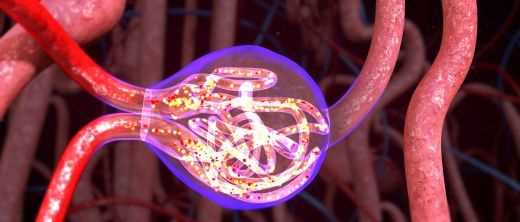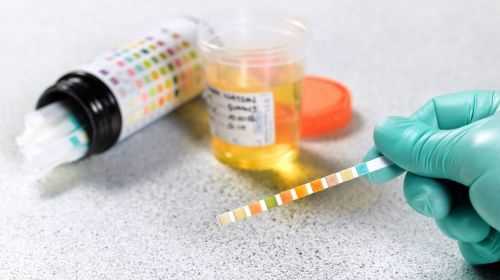Nephrotic syndrome is a disease of the kidney corpuscles in which they no longer properly filter the urine. As a result, too much protein is excreted in the urine. Children can also be affected. Everything about causes, symptoms and treatment options.
Nephrotic syndrome comprises a variety of symptoms that are caused by damage to the kidney. The organ’s filtering capacity is disturbed, as a result of which important proteins are excreted in the urine.
At a glance:
Kidney function: filter for pollutants
The kidneys filter over 1000 liters of blood every day and ensure that pollutants are flushed out of the body via the urine. In addition, they are involved in the regulation of the mineral balance and blood pressure.
There are many thousands of so-called nephrons in the kidneys, which are functional filter units. They make the urine. The uppermost part of the nephrons, the so-called glomeruli (kidney corpuscles), is located in the renal cortex. These are very fine blood vessels that lie like a ball in a capsule (Bowman’s capsule). When blood flows through these fine vessels, the vessel walls act like a sieve: the blood pressure forces the liquid through. However, not all blood components can pass through the vessel and thus be excreted. The vessel walls are usually permeable to minerals, sugar, urea and water, but not to proteins and red and white blood components.
Damage to the kidney corpuscles disrupts this filtering capacity; it is no longer just salts and pollutants that are excreted, other substances such as important proteins (such as the blood protein albumin) also end up in the urine. As a result, a number of symptoms appear, which are summarized as nephrotic syndrome.
Nephrotic syndrome: symptoms
The central symptom of the nephrotic syndrome are proteins in the urine, they can be determined by laboratory diagnostics. Experts also speak of proteinuria. The proteins are not necessarily visible to the naked eye, but it can happen that the urine foams.
In the course of protein excretion in the urine, there is a protein deficiency in the blood, the so-called hypoproteinemia, especially of albumin. The protein is normally found in abundance in the blood and ensures that no fluid seeps from the blood into the surrounding tissue. If albumin is missing, because it is excreted by the kidneys, fluid can enter the tissue. So-called edema occurs, which is water retention. The fluid-induced swellings tend to occur on the face, predominantly on the eyelids, legs and feet, as well as on the hands. In women also on the labia and in men on the testicles. The swollen areas of the body can be easily indented. Further accumulations of fluid can occur in the abdomen (ascites) or in the area of the lungs (pleural effusion).
In addition, other complaints are common:
In addition, the increased excretion of important substances (such as minerals) can lead to deficiency symptoms and, as a result, to physical underdevelopment in children. The bones are vulnerable here; in the course of the nephrotic syndrome, demineralization of the bones can occur in connection with a vitamin D deficiency. The bones become poros (osteoporosis) and break more easily due to the lack of calcium.
In addition, the risk of thrombosis (formation of blood clots) is increased in nephrotic syndrome.
What are the causes of nephrotic syndrome?
The nephrotic syndrome always results from damage to the kidneys, especially the kidney corpuscles. Experts differentiate between two forms: in primary kidney disease, the damage comes from the kidneys themselves, i.e. a disease that affects the kidneys. In the secondary form, a disease initially affecting other organs is the trigger.
Causes of primary kidney disease are:
Secondary kidney disease is caused by:
Parasitic infections such as the tropical diseases schistosomiasis (schistosomiasis) and malaria can also cause kidney damage. Infection with the new SARS-CoV-2 virus can also damage the kidneys and cause nephrotic syndrome.
Nephrotic syndrome: these examinations confirm the diagnosis
Usually sufferers seek medical help based on symptoms, such as massive tissue swelling. The symptoms can also occur in the context of other diseases, such as liver failure or heart failure. Any previous illnesses and the exact symptoms are then recorded in an anamnesis interview. It is also relevant how long the complaints have existed.
Some laboratory tests are particularly important for making a diagnosis. As a rule, the first step is to check whether the urine contains protein. To do this, a test stick is held in the freshly released urine. If this is positive, a further analysis is made of how high the protein concentration in the urine is. In order to be able to determine the exact protein loss, the urine is collected over a period of 24 hours (24-hour collection urine) and then the albumin value is determined.
In addition, there are blood tests, they serve to confirm the diagnosis as well as to determine a cause for the disease. The blood is tested for:
In addition, further examinations may be necessary, such as a tissue examination of the kidney (biopsy) or imaging procedures such as CT (computer tomography) and ultrasound. In this way, further pathological changes in the kidneys can be made visible.
Treatment of Nephrotic Syndrome
If an underlying disease is the cause of the nephrotic syndrome, it is important to treat it first during therapy in order to prevent further damage to the kidney corpuscles. In addition, the treatment aims to alleviate discomfort and enable those affected to lead a good life.
Since one symptom of nephrotic syndrome is high blood pressure, antihypertensive drugs such as ACE inhibitors are often used. This is important because high blood pressure damages the kidneys and promotes the progression of the disease. If there is already renal insufficiency (kidney failure), the potassium level must be checked regularly when ACE inhibitors are administered, as the excretion of the mineral may be reduced. An increased potassium level can lead to dangerous cardiac arrhythmias.
In addition, the administration of diuretics (“water tablets”) can help to reduce the edema, and they also have a positive effect on increased blood pressure. In addition, so-called anticoagulants are administered, which have an anticoagulant effect and thus prevent thrombosis and embolism.
The blood lipid levels can be lowered with so-called statins, which is useful to prevent secondary diseases such as arteriosclerosis. Since sick people are often very susceptible to infections, certain vaccinations are recommended, such as against pneumococci and flu.
In addition, a low-fat and low-salt diet is advisable in order to contain the symptoms. Protein should be consumed in normal amounts through food.
In some cases – especially minimal change glomerulonephritis, which is common in children – the use of corticosteroids such as prednisone helps. They suppress the immune system (immunosuppressants). The drug is used for six to twelve weeks. In many cases, relapses occur after corticosteroid therapy, and then other drugs are given. However, taking such drugs is often associated with serious side effects, such as inhibiting growth in children.
What are the chances of recovery from nephrotic syndrome?
The prognosis depends primarily on the cause of the disease. If an allergy is the trigger, a medication or a drug, then stopping the harmful substance or avoiding allergens can have a positive effect on the course or even contribute to a complete cure. Even if an infection or cancer is the cause, consistent treatment sometimes also promises kidney recovery.
Often, however, the kidney damage has progressed to such an extent that there is a risk of kidney failure and only dialysis (blood washing) or a kidney transplant can help.
The prognosis for children with nephrotic syndrome is usually good, and the disease occurs in phases. Affected children do not have to take it easy and with the help of medication and the right diet, they can do everything that other children do and go to school normally.



